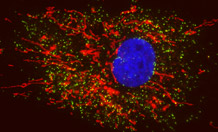
Peroxisomes (green) and mitochondria (red) in a mammalian cell. The nucleus (blue) contains the cellular DNA.
Study of the machinery of cells reveals clues to neurological disorder
Investigation by researchers from the University of Exeter and ETH Zurich has shed new light on a protein which is linked to a common neurological disorder called Charcot-Marie-Tooth disease.
The team has discovered that a protein previously identified on mitochondria - the energy factories of the cell - is also found on the fat-metabolising organelles peroxisomes, suggesting a closer link between the two organelles.
Charcot-Marie-Tooth disease is currently incurable and affects around one in every 2,500 people in the UK, meaning that it is one of the most common inherited neurological disorders, thus understanding the molecular basis of the disease is of great importance. Symptoms can range from tremors and loss of touch sensation in the feet and legs to difficulties with breathing, swallowing, speaking, hearing and vision.
The research published online in EMBO Reports combines work from University of Exeter Biosciences researcher Dr Michael Schrader and PhD student Sofia Guimaraes. The major finding of the study is that the protein GDAP1, originally thought to only be involved in fragmentation of mitochondria, also contributes to the regulation of peroxisome number through their division.
Peroxisomes are small organelles occurring in nearly all cells, from yeast to crop plants to humans, and are essential for cell viability due to their important role in the metabolism of fatty acids and reactive oxygen species. Peroxisomes are also of particular interest as they play a key role in ageing.
This current study shows that the division of both mitochondria and peroxisomes follows a similar mechanism, although many of the disease-causing mutations occur in a region of the gene that is more critical for mitochondrial than peroxisomal division.
Dr Michael Schrader said of this project: “This study supports our hypothesis of a closer connection between mitochondria and peroxisomes. We have identified several membrane proteins, which are shared by both organelles, particularly key components of the division machinery, meaning there must be coordinated biogenesis and cross-talk.”
As numerous diseases have been linked to problems in the mitochondria, Dr Schrader proposes that this connection could have far-reaching medical implications.
This work contributes to the research being addressed through the prestigious Marie Curie Initial Training Network PERFUME programme (PERoxisome, FUnction, and MEtabolism), recently awarded to Michael Schrader along with several other top European research groups which focus on peroxisome biology.
Article produced by Kate McIntosh, PhD Student, Biosciences.
Date: 16 May 2013
